Axel's Parents
Chris Boilesen and Elizabeth 'Lizzie' Adel Jensen Boilesen
The Parents of Axel Boilesen
By Doug Boilesen (one of the grandkids and a Phonographian) 2014
This is an annotated scrapbook of Chris and Elizabeth Boilesen, parents of Floyd (1915-1988), Lester (1918-1994), Lois (1919-2007), Fern (1921-1990), Axel (1923-2013), and Garold (1935-2023). Photos, newspaper clippings, history and some recollections are primary sources. The title is "Axel's Parents" but obviously it should be called "Parents of Floyd, Lester, Lois, Fern, Axel and Garold." I've left it with its original name (with apologies to my cousins) since it's just one of the larger set of "Axel Growing Up" stories (which of course all started with documenting his Memories of the Phonograph story).
Chris Boilesen (aka 'Pop' or 'Papa') was born on March 24, 1889 in Dannevirke, Nebraska and died on February 19, 1976. Chris had seven sisters and two brothers. Chris's father, Axel Christian Boilesen, died on July 20, 1903. Chris's mother married Martinus Andersen on July 3, 1906. Chris soon ventured to California but returned to Nebraska and married "Lizzie" Jensen on April 8, 1914.
Elizabeth 'Lizzie' Adel Jensen Boilesen (aka 'Mom' or 'Momma') was born on March 29,1896 in Dannevirke, Nebraska and died on May 27, 1968. Lizzie had one brother and six sisters.
"In his young days Pop worked in California" according to Garold, his youngest son, but he never did discuss his time in California with Garold. This 5" x 7" photograph is simply identified in pencil on the back "Del Ray Calif 1908" and it is believed that Chris worked on a truck farm while in California.
Del Ray, California 1908
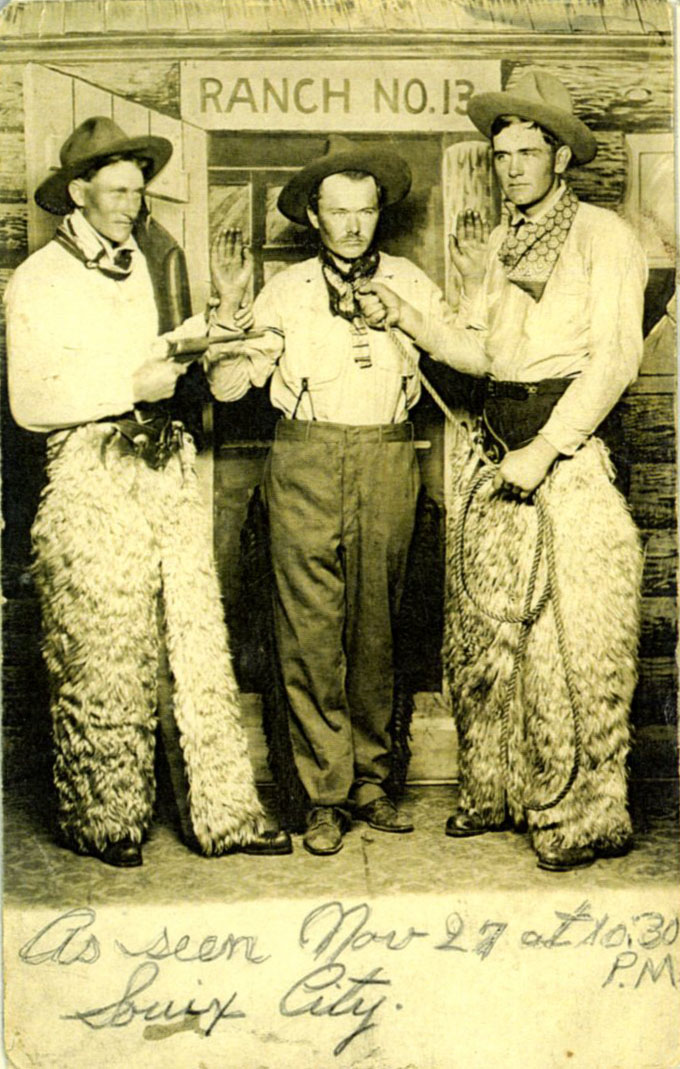
Postcard taken at a photo studio in Sioux City, Iowa and sent to Lizzie Jensen November 27, 1913 (L-R Chris Boilesen, Chris Gregerson, Chris Nielsen)

Chris and Elizabeth were married on April 8, 1914 at St. Paul, Nebraska.
One hundred and eighty (180) Howard County men were called for Examination at the Court House for the World War I first draft, August 1, 1917. Chris Boilesen was Draft Order Number 138, Serial Number 388. As a farmer he received a deferment. The Phonograph newspaper in St. Paul, Nebraska published the list of the 180 on August 2, 1917
![]()
Chris and Lizzie had four boys and two girls.
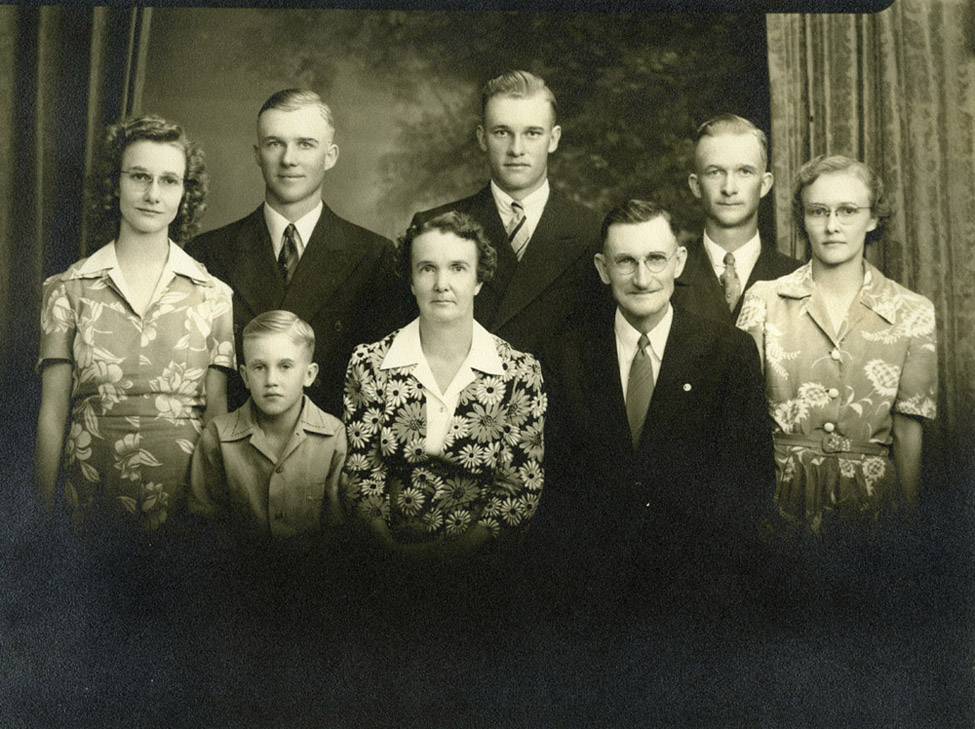
Chris and Elizabeth Boilesen family portrait, circa 1941, Cotesfield, NE; Back row L-R: Floyd, Axel, Lester; Front row L-R: Fern, Garold, Elizabeth, Chris, Lois.
When you live in a small town like Cotesfield a variety of family activities are reported in the local newspaper. Communities in Howard County each had their own correspondent who would provide their town's news to the local newspaper, The Phonograph, in St. Paul, Nebraska.
The following include Cotesfield items in The Phonograph newspaper that document some Boilesen "news" during the years Chris and Lizzie were raising their family. Other references can be found in The Phonograph related to their 'birthday and wedding anniversaries', visitors coming to dinner, funerals, and gatherings they attended. Most of these clippings here, however, are glimpses of their lives "in sickness and in health" and are like reading from a family diary about things that otherwise would not now be known.
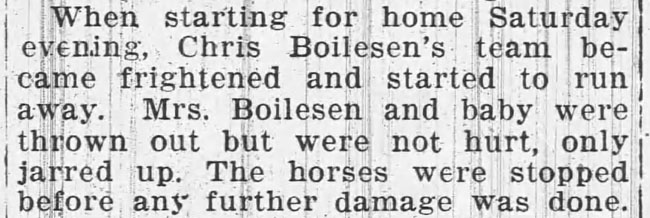
The Cotesfield Department: The St. Paul Phonograph, Monday, July 15, 1918
In the above account Floyd (two-years 9 months) was the baby thrown from the wagon with his mother. Lester would be born six weeks later.

The Cotesfield Department: The St. Paul Phonograph, Thursday, July 18, 1918
This seems to be additional information about the previous week's Saturday evening when Mrs. Boilesen was returning home from Dannebrog and was thrown out from the wagon with her baby (see July 15, 1918 above).

Cotesfield: The St. Paul Phonograph, February 15, 1922

Cotesfield: The Phonograph, St. Paul, Nebraska February 3. 1926.
All six children of Chris and Elizabeth were born and raised on their farm west of Cotesfield,

Photo taken 70 years after the Parker house (on right) was moved and added to the Boilesen house west of Cotesfield.
The original Chris and Elizabeth Boilesen homestead barn as seen in 2013 approximately 100 years after it was built. The house and blacksmith shop are no longer standing nor are there any of the other 'systems' that Chris added to make life better for his family in the 1920's and 30's.

Cotesfield: The Phonograph, St. Paul, Nebraska September 7, 1927

Cotesfield News: The Phonograph, St. Paul, Nebraska April 4, 1928

Cotesfield News: The Phonograph, St. Paul, Nebraska January 30, 1929
(In a January 9 newspaper article Axel was identified as the sick child)

Cotesfield Department: The Howard County Herald, St. Paul, Nebraska August 14, 1929

Cotesfield News: The Phonograph, St. Paul, Nebraska November 14, 1934
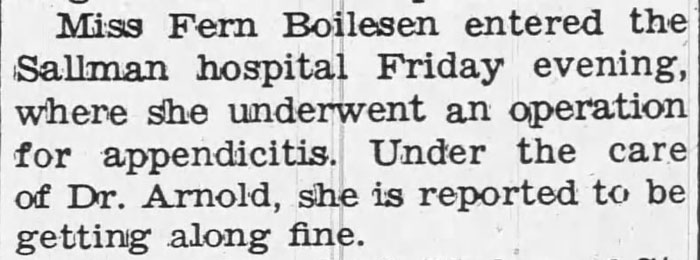
The Phonograph, St. Paul, Nebraska Wednesday, May 5, 1937
The Friday evening reference would mean that Fern must have gone into Hospital on the previous Friday, April 30, 1937.
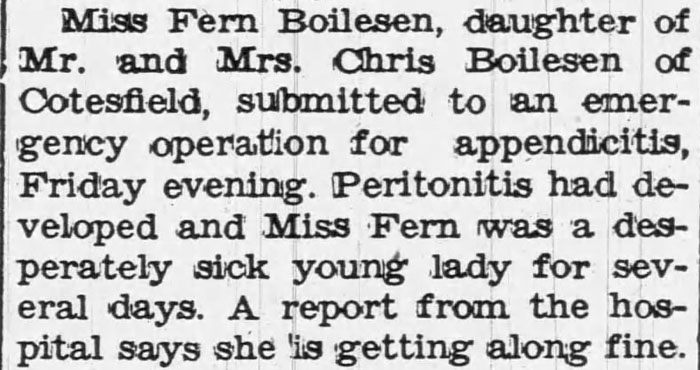
The Phonograph, St. Paul, Nebraska May 12, 1937

The Phonograph, St. Paul, Nebraska May 12, 1937
Fern was released from hospital on June 9, 1937, 5 weeks after surgery.
From these items we learn that Fern had an emergency operation for appenditis and was in hospital from April 30 until June 9. The seriousness of Fern's operation and her recovery may be the reason that her mother ended her daughters' participation in dancing and playing cards, and may also have triggered a re-emphasis on the importance of religion.
The Phonograph, St. Paul, Nebraska October 27, 1937
Garold summarized his mom's religion as being "pretty strict" recalling that she didn't approve of working or shopping on Sundays; no going to the movies although in high school after the Youth Meeting on Sunday evenings Garold and a couple of his friends would chip in for gas and drive to St. Paul in his '41 Buick to catch the last movie of the night. When he would come home late his parents were already in bed but his mom would always call out "Is that you Garold?" and he would say yes and then go upstairs to bed so her acceptance of movies had apparently softened.
Garold remembers that every Sunday he would go to Sunday School while his parents went to adult Sunday School and then they would all go to church service together. When he was really young on one occasion Garold said he was once so disruptive in Sunday School that the teacher told him if he didn't shape up he was going to get separated. Garold said he didn't know what that meant but that he knew what a cream separator did and was quite worried that his punishment would involve that separator.
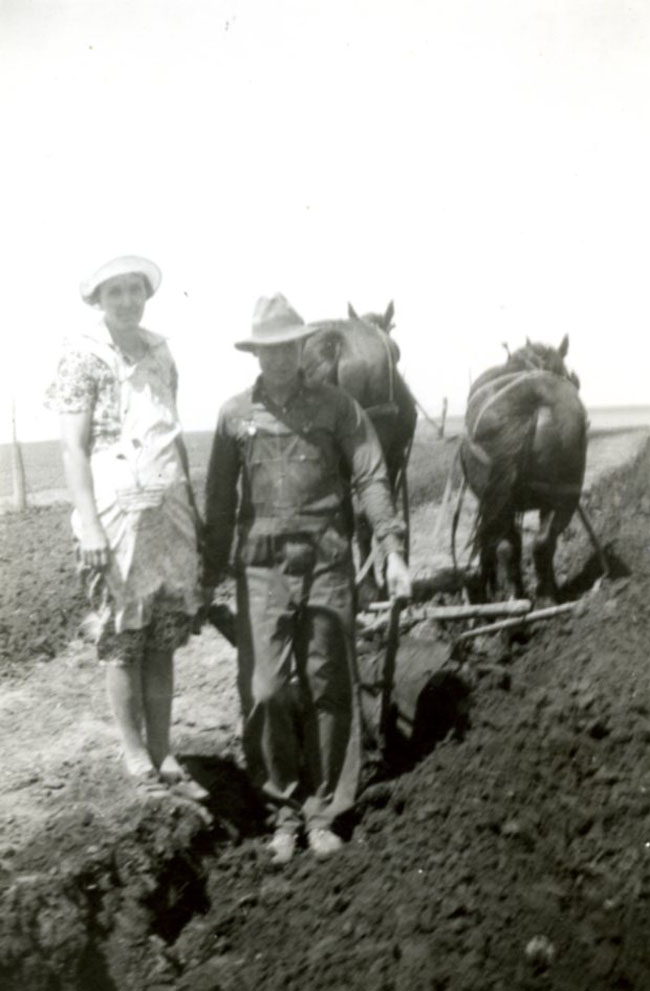
""Momma & Axel planting potatoes in the old garden, 30th April" (ca. 1938)
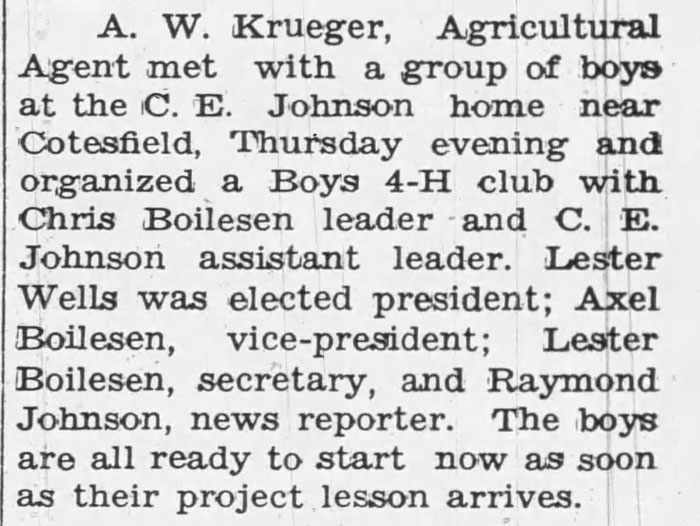
The Phonograph, St. Paul, Nebraska February 17, 1937
In the Home
One of the activities I didn't realize went on for so long at my grandparents' farm was their butter making. According to Garold when he was a boy in the early 1940's one of his chores was to 'churn' the butter. This involved moving the wooden dasher up and down in their four-gallon churn (i.e., stoneware crock with lid and hole in its center). The first butter factories appeared in the United States in the early 1860s and at the end of the 19th century even the small town of Elba, just south of Cotesfield, had their own cheese and butter factory. Elba's butter factory didn't last but even if had survived it's doubtful that my grandparents would have spent their money on that butter or butter from any store. They had a few milk cows, a cream separator and it was something they had always done. My only surprise was how long they continued to do it.


Making and mending clothes was another activity that is hard for later generations to fully appreciate what a difference something like the invention of the sewing machine meant to a family.
My grandmother's treadle (non-electric) sewing machine was positioned against the wall in the front room of their house. It was one of the few pieces of 'furniture' that I remember and its functionality made it an important part of their home. I'm not sure my grandmother ever had another model than this gold stenciled "Wright Special" Manufactured by Wright & Wilhelmy Co., Omaha, Nebr. According to the Douglas County Historical Society "the Omaha-based Wright & Wilhelmy Co. Wholesale Hardware firm was rather ubiquitous in eastern Nebraska for much of the 20th century. The company was founded by John F. Wilhelmy and H. Larson in Nebraska City in 1871. They functioned as both a retail and wholesale hardware supplier." It seems likely, therefore, that Wright & Wilhelmy weren't manufacturing sewing machines but were buying sewing machines and then selling them with under their company name by catalogue or as a wholesaler to local stores.
Speaking of needles, and as a Phonographian, I also love the following Wright & Wilhelmy Co. photograph of their salesmenís Fords with sample phonographs strapped to the backs. Obviously a good company to purchase a sewing machine from as historically there is a close connection between sewing machines and the phonograph.
Courtesy of the Douglas County Historical Society
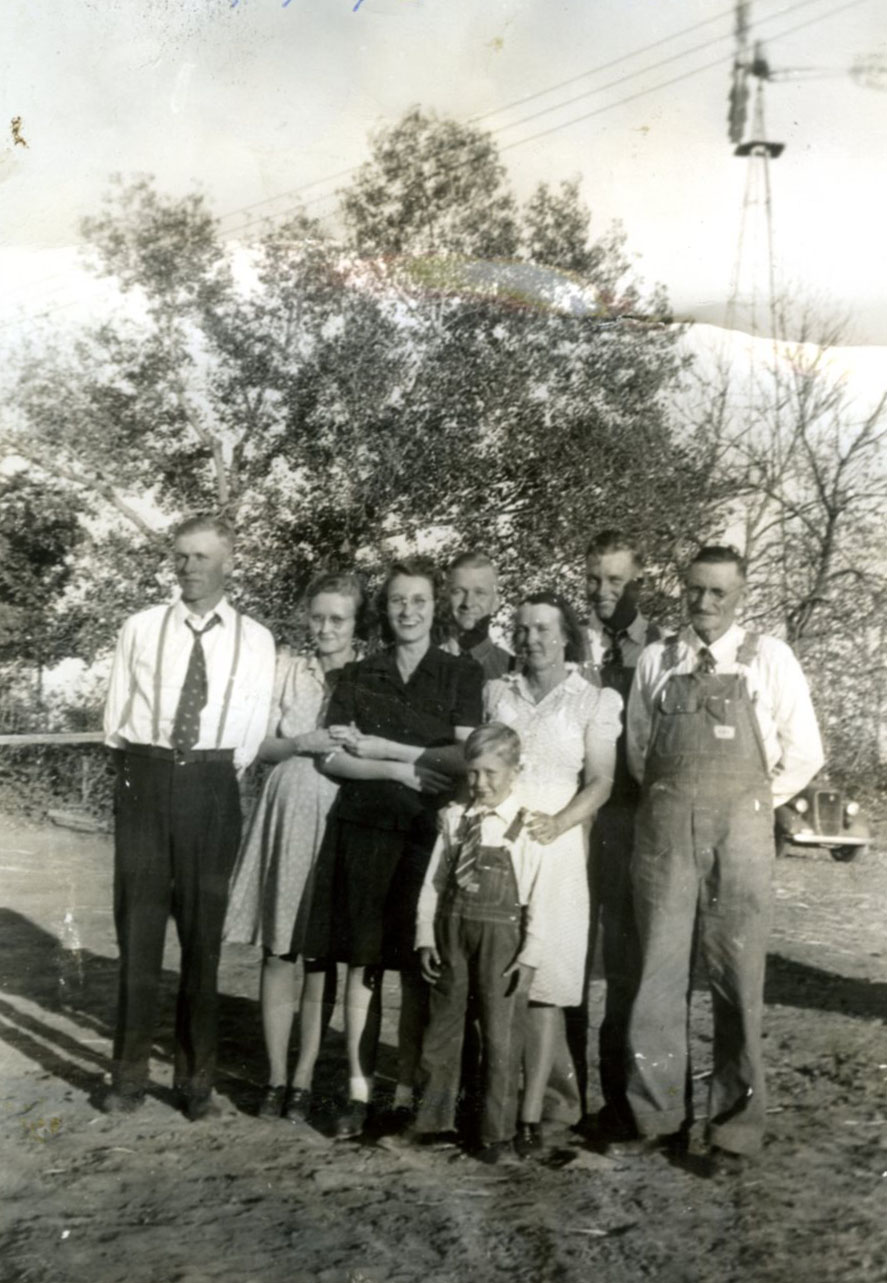
The Boilesen's 1940
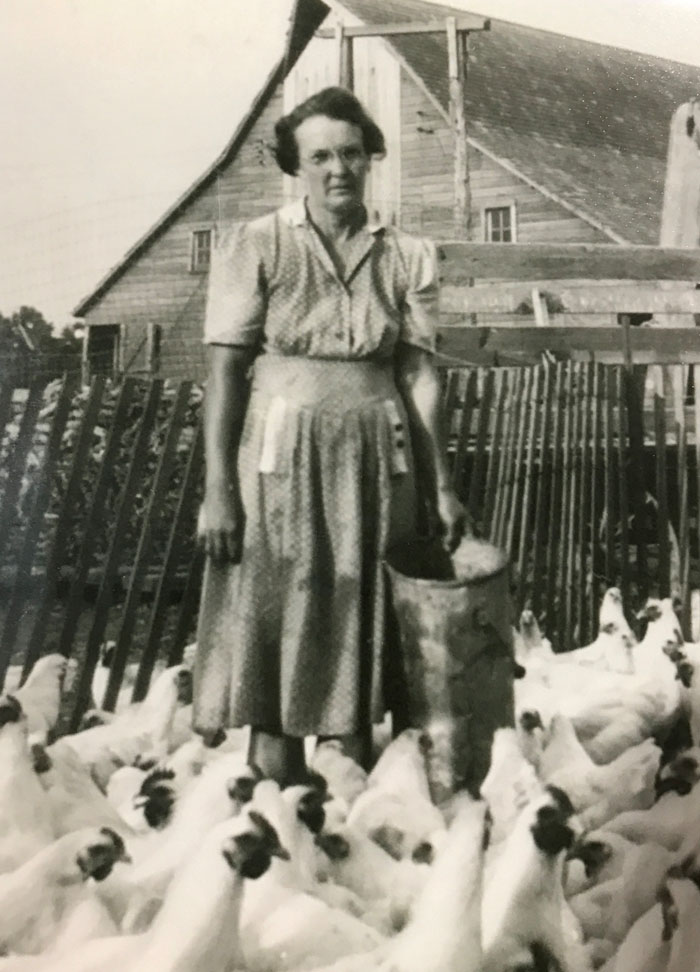
On their farm across the river east of Cotesfield ca. 1945

Newspaper ad, March 21, 1929, The Scotia Register
Eggs and cream were two products that Mrs. Chris Boilesen would sell through the decades. Garold remembers their cream separator and the cream that they would take to the creamery in Cotesfield with the proceeds used for buying groceries. Garold doesn't know if his parents ever sold milk but since they only had a couple of dairy cows when he was growing up he knows that the milk from those cows was for their own use and for the cream that could be sold.
Chris was seriously injured in 1948 when his tractor rolled over on him while is was mowing alfafa on the hill near the entrance to their farm. The frequency of farm accidents is a statistic that too often goes unnoticed. Likewise, the spirit of helping neighbors in times of hardships is a proud tradition of Nebraska farmers and worthy of recognition.
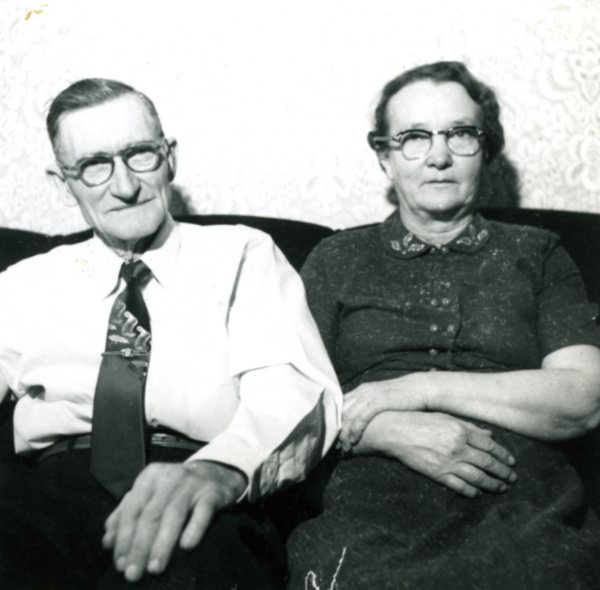
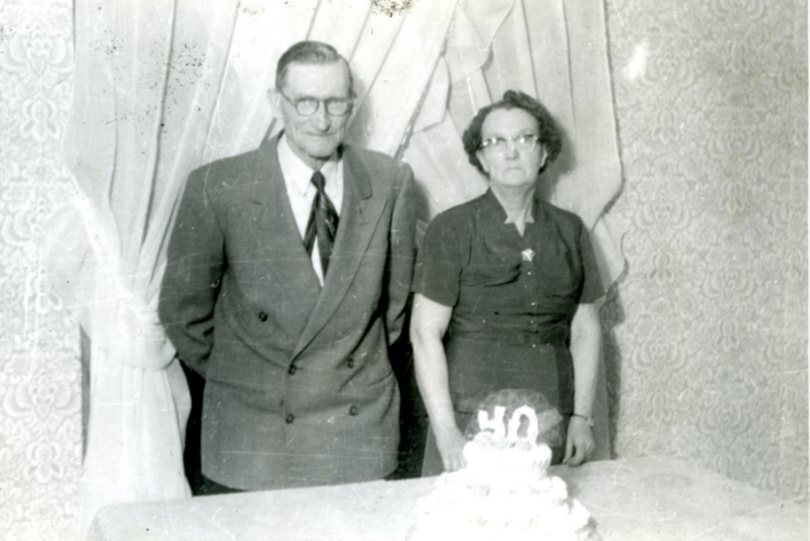
40th Wedding Anniversary - 1954

Chris and Lizzie in the Mojave Desert, 1958. They travelled by train to visit Garold who was stationed there in the Air Force and also to attend a Danish Brotherhood Convention in San Bernardino. Garold remembers taking his dad to a boxing match at a local venue in San Bernardino where "the beer was flying."
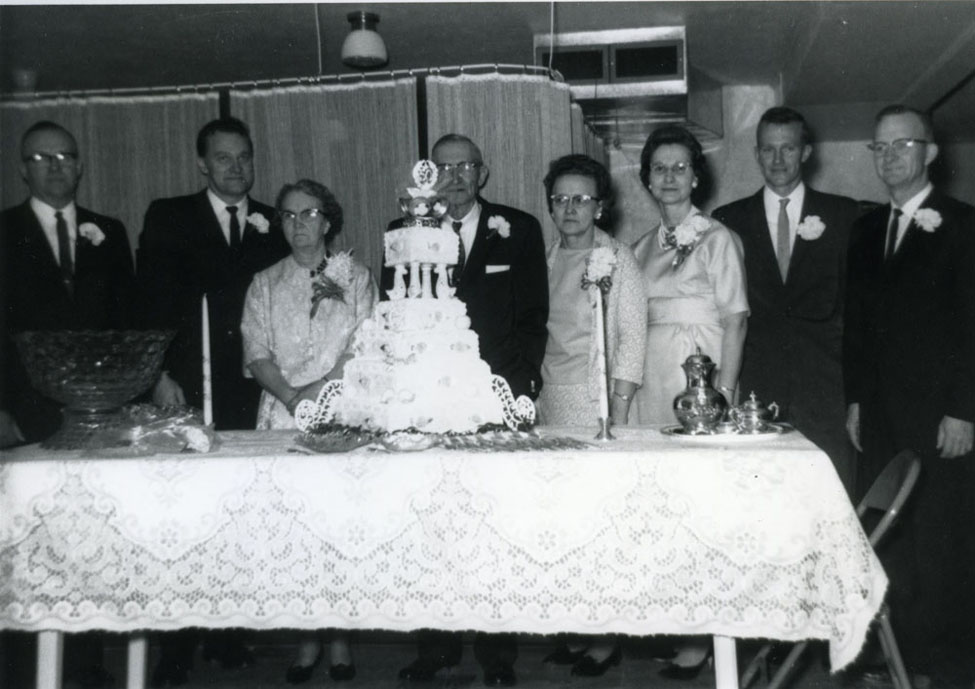
1964 Golden Wedding for Chris and Elizabeth Boilesen - L-R Floyd, Axel, Elizabeth, Chris, Lois, Fern, Garold, Lester

Golden Wedding of Chris and Elizabeth Boilesen - Grandchildren
L-R Janice, Russell, Leila, Carol, Gloria, Gaylord, Sheryl, Crysta, Jeanne, Ila, Eugene, Doug (front row Bev, Susan)
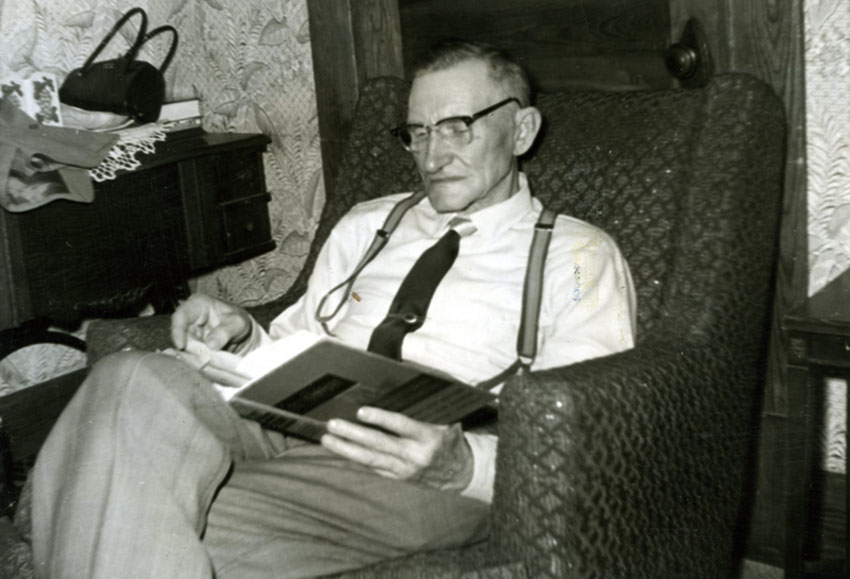
Popular Culture on the farm
In the years from 1915, when their first child was born, until 1954 when the last one left, many changes occurred in popular culture. The telephone, automobile, phonographs and recorded sound, music, movies, radio, television and print media altered what Americans were seeing, hearing and doing. Consumerism changed what and how goods were produced and sold; the Rural Electrication Act brought electric lights and power to rural communities. And, of course, there were the life-changing events of those eras with their indelible impact: the 1918 influenza pandemic, the Wall Street Crash of 1929, the Great Depression, drought, two World Wars and the Korean War.
On the farm in rural Nebraska having chickens and a few pigs or cows and a garden provided food many weren't as fortunate to have during economic hardtimes. On the other hand, farming in the 1930's 'dust bowl' was a daily reminder that without water nothing grows and all you could do was watch the topsoil literary blow away. Axel remembered going out each day during the drought years and walking behind his plow and horse and feeling like he was simply walking in circles; it was hot and dusty, and at the end of each day he felt like nothing had been accomplished and that the same would be true the next day.
Everyone in the family except Garold lived all their growing up years on the original Boilesen farm west of Cotesfield in the house where each had been born. Axel remembered it as being a nice home. He shared a room with his two brothers Floyd and Lester and they all slept in the same bed. Two would sleep with their heads at the top of the bed while the third brother slept at the other end with his feet pointing towards his two brothers' heads. Axel said he didn't think their sleeping arrangement was ever a problem. But when he did visit that farm home some sixty years later he was surprised how small it seemed. Interestingly, he also expressed some disappointment that he had even revisited it as it was empty, run-down, and far different from what he remembered.
Books seem to have had a limited place in the home except for the Bible which was kept on the parlor's sideboard. The children had some books in the china cabinet. The Big Little Books from the 1930's like Tarzan and Dick Tracy were favorites. Garold remembers that after church every Sunday they would go to their Cotesfield post office box and get their Sunday newspaper which he enjoyed for its Sunday Funnies. Garold listened to a few radio shows that were also in the comics such as Jack Armstrong, The Lone Ranger and Terry and the Pirates. Axel remembered The Katzenjammer Kids, Bringing Up Father, Dick Tracy, Popeye and Little Orphan Annie as ones that he had read.
1948 (Click to see full panel)
See Axel's "Growing Up - What did we do for entertainment?" for some of his other entertainment memories.
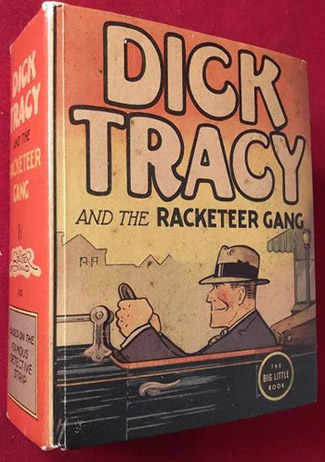

Dick Tracy, The Big Little Book (1936) and Tarzan of the Apes (1933)
Chris followed politics and liked talking about the issues of the day but I don't know any books he may have read. Elizabeth read the Bible but again I don't know any other books she may have read.
Axel remembered a radio being in the parlor. Garold remembers a small wooden cased radio in the kitchen (probably in the 1940's and early 1950's). Because Chris was such a supporter of FDR it seems likely that FDR's "Fireside Chats" would always have been tuned in.
Interestingly, Chris attended a speech of President Roosevelt in Omaha in 1936.
Cotesfield News: The Phonograph, St. Paul, Nebraska October 14, 1936
Elizabeth regularly listened to Reverend Epp on "Back to the Bible" and to Rev. Charles Fuller on The Old Fashioned Revival Hour. The farm and market reports and the weather reports which had an early history and influence on Nebraska farmers were a daily staple in the house. KFAB started a program in 1926 (1) featuring market reports and talks on farming and likewise KFKX Hastings (2) and KMMJ Clay Center, Nebraska began broadcasting market reports in 1926. (See Jim McKee's Memories and Moments for more history of Rural Radio, Lincoln Journal February 20, 2022)
They subscribed to several newspapers over the years including The St. Paul Phonograph, aka Howard County Herald, The Scotia Register and a Sunday newspaper (perhaps the Omaha World Herald).
Cotesfield News: The Phonograph, St. Paul, Nebraska January 25, 1928
Garold remembers The Saturday Evening Post being in the house, the Farm Journal, Danish Brotherhood newsletters, and perhaps Life magazine.
Catalogs like Montgomery Wards and Sears were always welcomed as this was the wish book era and actual shopping trips were limited.
An Edison Amberol Phonograph was in their home in the 1920's and 1930's although Axel remembers it mostly being kept in the closet. "The Jolly Coppersmith" was one of his favorites. He also remembered that he used to watch Lois and Fern dance around to its music. They had it until World War II when it was donated to support the war effort with Chris thinking that it might be used to entertain the troops. See Axel's Memory of the Phonograph for more details.
There was never a television while Garold lived at home so TV wasn't part of the Boilesen home until sometime after 1954. The Lawrence Welk Show was a favorite for both with Chris adding Saturday Night Wrestling to his weekly program list. Garold didn't know what his mom thought about that additonal selection by his dad.
The farm west of Cotesfield had a icebox and an ice house but making ice cream was infrequent. The Deland Drug Store was the place to go for a special ice cream (like a peanut buster) or a frozen Milky Way. Visits there, however, also weren't common.
Cotesfield had their own telephone co-op and the Boilesen's always had a phone on their farm. Garold remembers in high school that he once went to Deland's because it was the only public telephone in town and he wanted to make a personal call for a potential date (which he didn't want to do from home because of his parents being around and because of their party-line). The drug store phone, however, wasn't in a phone booth and was located where Harry Deland and anyone else could listen. After surveying the situation Garold left the store without making that call.
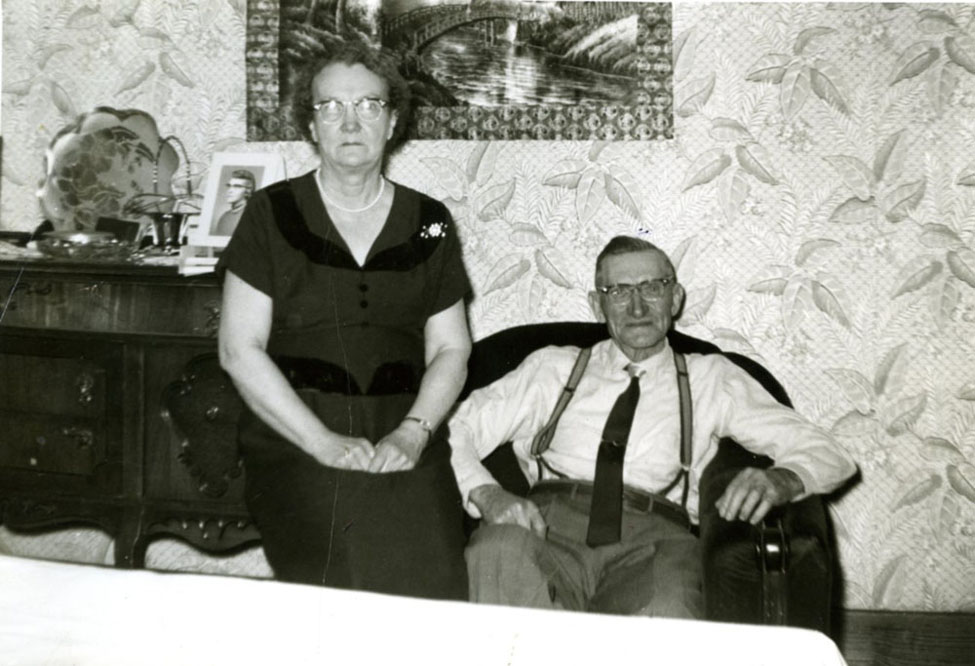
Chris and Lizzie in their living room across the river farm circa 1959
Chris Boilesen's work outside of farming
The family had a farm west of Cotesfield until they moved to another farm east across the river in the summer of 1943. Chris and Lizzie would make one final move buying a house in Cotesfield in 1960 across the street south of the school. They moved their kitchen cabinets and appliances from their farm house to the Cotesfield house.
The sons did much of the farming in the late1930's as Chris was working on Howard County projects in St. Paul such as the Rural Electrication Association, the Howard Country Public Power District and the district's new Soil Conservation Program. Upon his retirement he received a watch celebrating his year's of service to agriculture and the region inscribed as follows: "March 1936 - January 1971 Howard Greeley Public Power District Chris Boilesen Director."

The Howard County Herald, St. Paul, Nebraska February 27, 1935

Chris Boilesen (front row, second from left) worked for the REA in St. Paul Nebraska, photo circa 1936
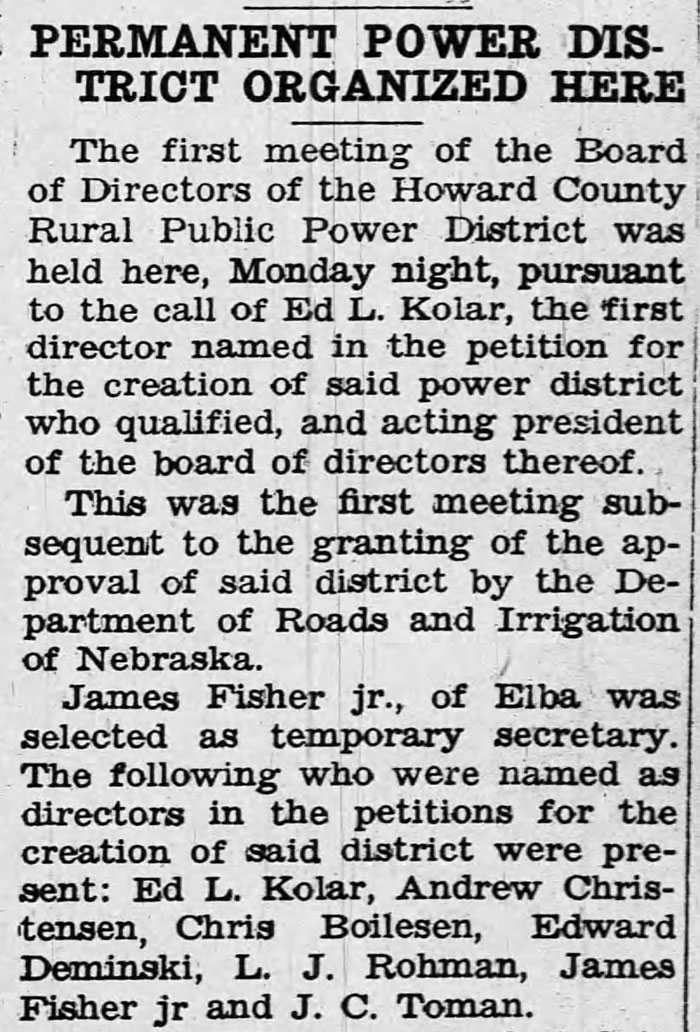
Cotesfield News: The Phonograph, St. Paul, Nebraska March 18, 1936
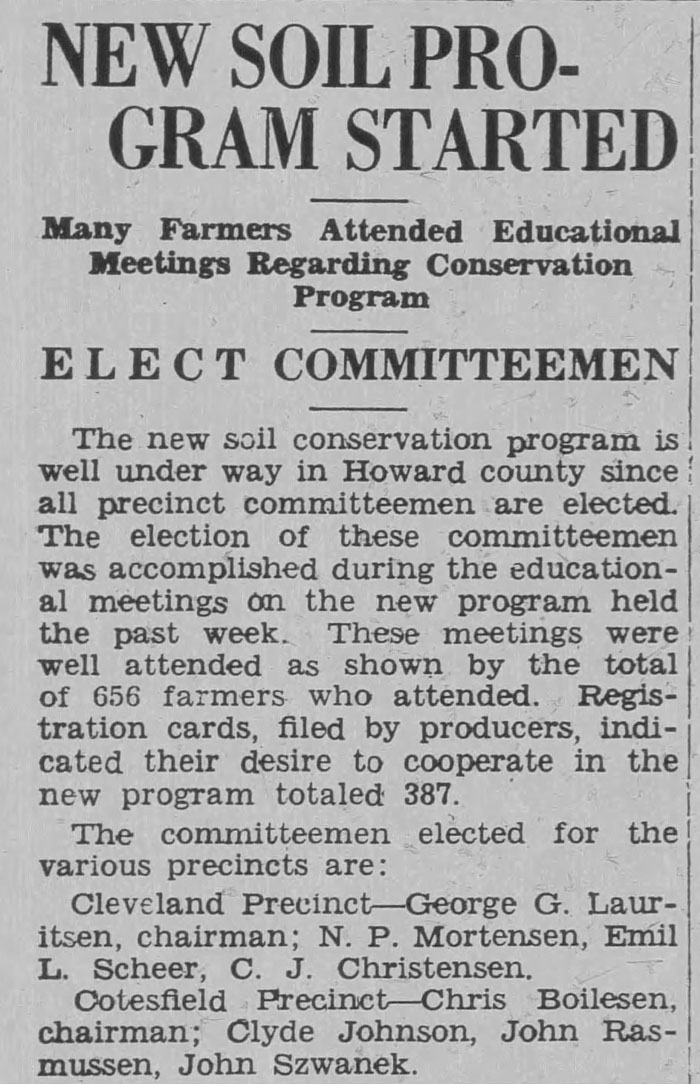
The Howard County Herald, St. Paul, Nebraska April 8, 1936
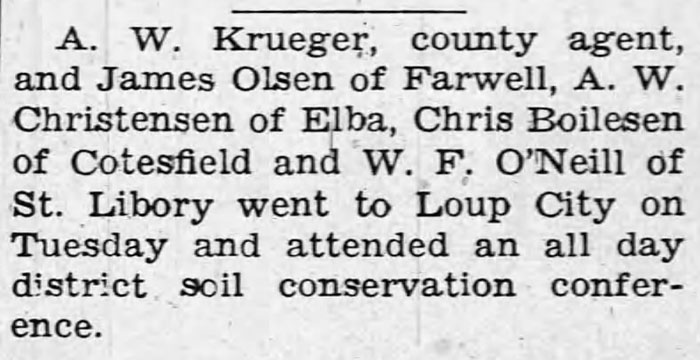
Cotesfield News: The Phonograph, St. Paul, Nebraska April 29, 1936
Community Committees under the Soil Conservation Program
Elected Committees for 1938


The Phonograph, St. Paul, Nebraska, December 15, 1937
HOWARD COUNTY A LEADER IN RURAL ELECTRIFICATION
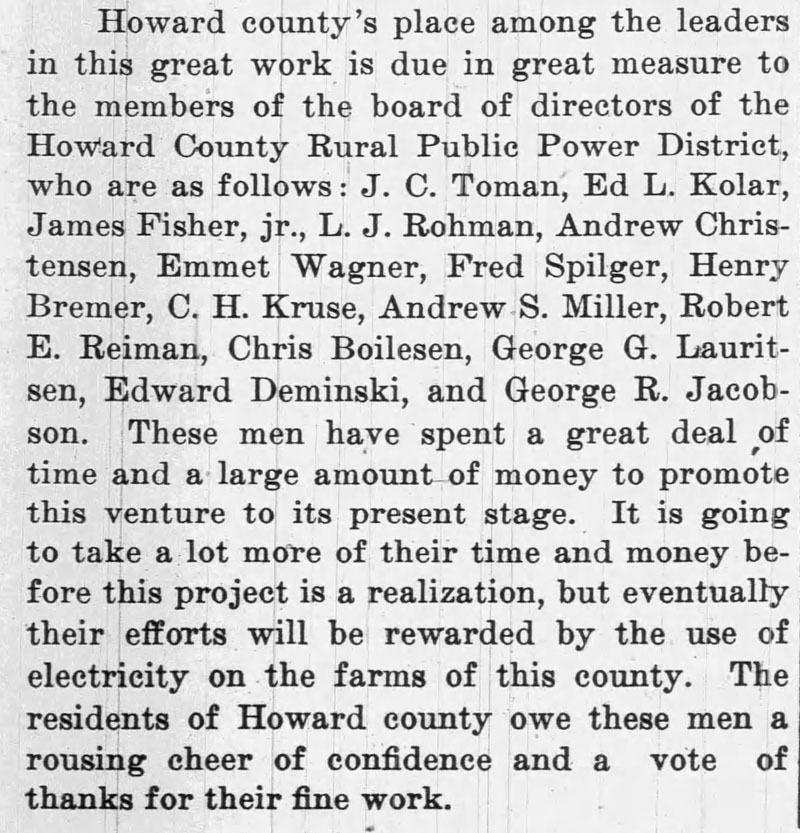
The Phonograph, St. Paul, Nebraska, March 31, 1937, p.2
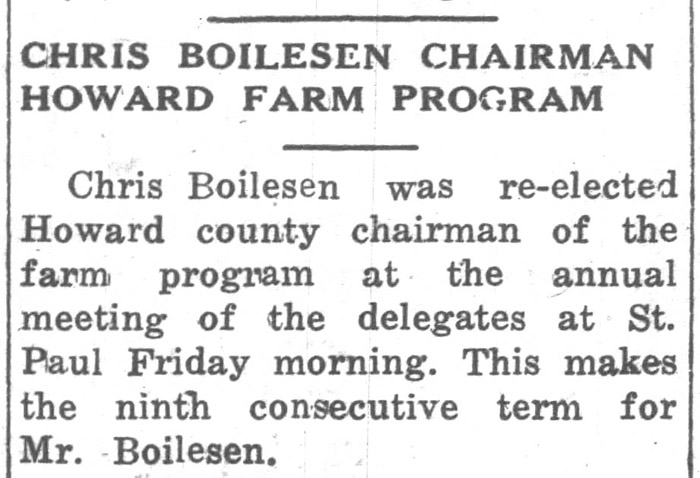
The Scotia Register, December 18, 1947
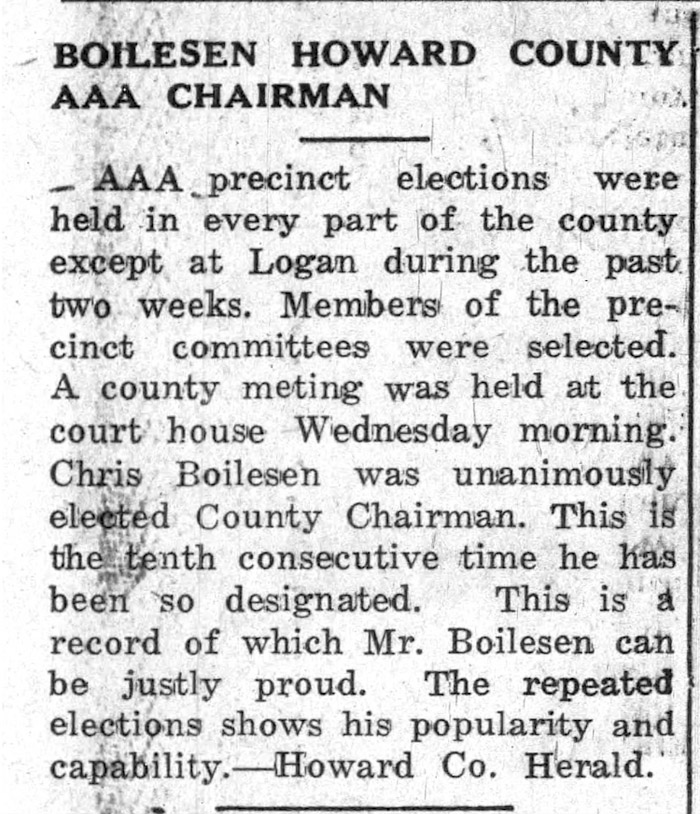
The Scotia Register, December 30, 1948

the magazine, Vol. 2 No. 1, @1979 Department of English, University of Nebraska-Lincoln
For information about Chris and Elizabeth Boilesen's parents and their family tree, see Axel's Grandparents.